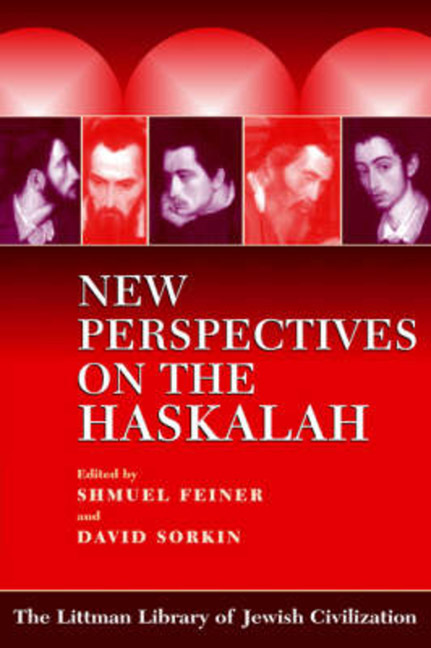Book contents
- Frontmatter
- Preface
- Contents
- Note on Transliteration
- Introduction
- 1 The Early Haskalah
- 2 Naphtali Herz Wessely and the Cultural Dislocations of an Eighteenth-Century Maskil
- 3 Enlightenment Values, Jewish Ethics: The Haskalah's Transformation of the Traditional Musar Genre
- 4 Was there a ‘Haskalah’ in England? Reconsidering an Old Question
- 5 Strategy and Ruse in the Haskalah of Mendel Lefin of Satanow
- 6 The Struggle of the Mitnagedim and Maskilim against Hasidism: Rabbi Jacob Emden and Judah Leib Mieses
- 7 Magic and Miracle-Workers in the Literature of the Haskalah
- 8 Portrait of the Maskil as a Young Man
- 9 Reality and its Refraction in Descriptions of Women in Haskalah Fiction
- 10 Enlightened Rabbis as Reformers in Russian Jewish Society
- 11 Towards a Historical Definition of the Haskalah
- Glossary
- Notes on Contributors
- Bibliography
- Index
9 - Reality and its Refraction in Descriptions of Women in Haskalah Fiction
- Frontmatter
- Preface
- Contents
- Note on Transliteration
- Introduction
- 1 The Early Haskalah
- 2 Naphtali Herz Wessely and the Cultural Dislocations of an Eighteenth-Century Maskil
- 3 Enlightenment Values, Jewish Ethics: The Haskalah's Transformation of the Traditional Musar Genre
- 4 Was there a ‘Haskalah’ in England? Reconsidering an Old Question
- 5 Strategy and Ruse in the Haskalah of Mendel Lefin of Satanow
- 6 The Struggle of the Mitnagedim and Maskilim against Hasidism: Rabbi Jacob Emden and Judah Leib Mieses
- 7 Magic and Miracle-Workers in the Literature of the Haskalah
- 8 Portrait of the Maskil as a Young Man
- 9 Reality and its Refraction in Descriptions of Women in Haskalah Fiction
- 10 Enlightened Rabbis as Reformers in Russian Jewish Society
- 11 Towards a Historical Definition of the Haskalah
- Glossary
- Notes on Contributors
- Bibliography
- Index
Summary
‘O Hebrew woman, who can fathom your life?’
JUDAH LEIB GORDON Kotso shel yodTHIS chapter will examine the relationship between the extra-literary reality of women's lives and the attitude towards them in European Jewish society of the nineteenth century, and the portrayal of female characters in the fiction of the Haskalah.
Literature never directly reflects reality but at most refracts the given historical moment. The transition from the actual ‘environment’ of history to its literary counterpart involves fundamental changes resulting partly from the author's personality and partly from the inherent assumptions and requirements of the literary medium. For the literary critic the social environment serves as a frame of reference for gauging the changes that have taken place in the ‘literary environment’— the work itself. Once the historical reality has been defined, it is possible to identify the literary features of the fictional characters. As far as the prose works of the Haskalah are concerned, the refraction of reality can be examined from two points of view. One is the extent to which the maskil's socio-historical reality affected his fictional descriptions; the other is the manner in which literary models, genres, and traditions contributed to the portrait of his fictional characters.
THE MALE-ORIENTED CHARACTER OF HASKALAH LITERATURE
In considering the portrayal of female protagonists in the prose works of the Haskalah, the fact that this is male literature par excellence is highly significant. Not only was this literature male-authored, but it was addressed to a predominantly male readership (at least until the 1870s, as will be clarified below). Socially the maskil can be defined as a male member of the social class known as the lomedim (studying) circles. This definition, which has gender-related social and cultural overtones, largely accounts for the male bias permeating the descriptions of women in Haskalah literature.
The maskil had to be a lamdan (a scholar) because of the inherent connection between Haskalah and the Hebrew language. A good understanding of Hebrew was a precondition for becoming even a reader of Haskalah literature. Those who had learned basic Hebrew, but did not go far beyond the education of the ḥeder, were unable to understand the rich and sophisticated Hebrew texts of the Haskalah; this privilege was reserved to those who continued their studies in the yeshiva.
- Type
- Chapter
- Information
- New Perspectives on the Haskalah , pp. 144 - 165Publisher: Liverpool University PressPrint publication year: 2001



